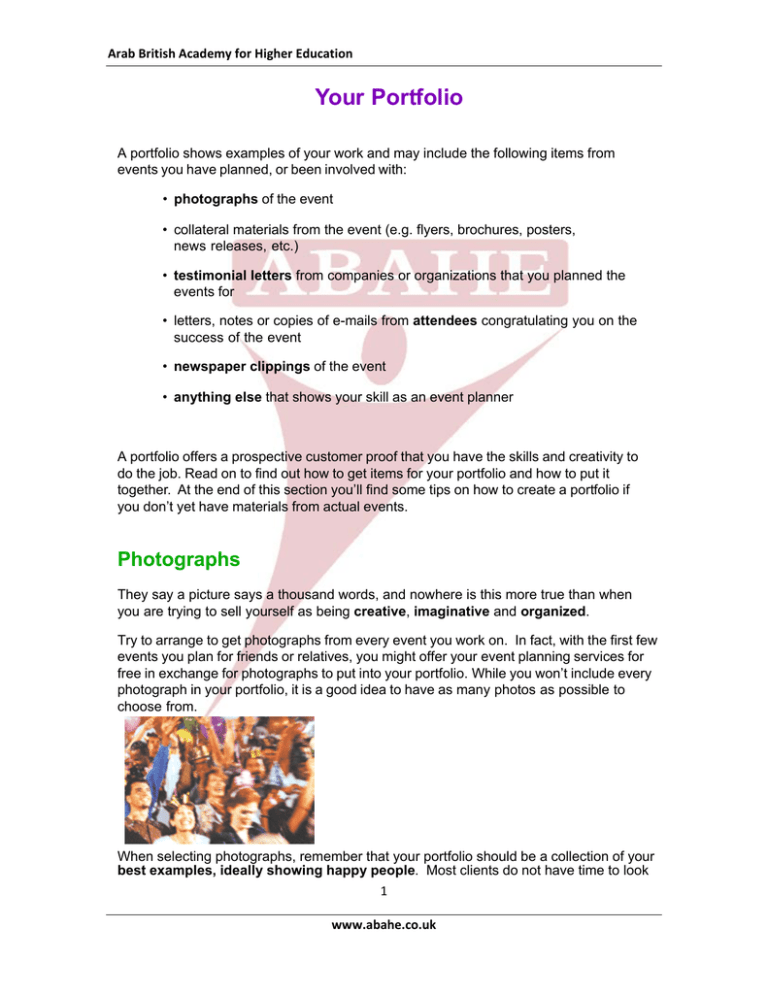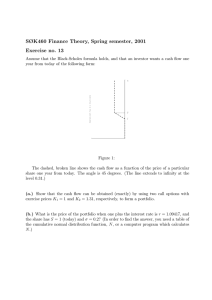
Arab British Academy for Higher Education Your Portfolio
A portfolio shows examples of your work and may include the following items from
events you have planned, or been involved with:
• photographs of the event
• collateral materials from the event (e.g. flyers, brochures, posters,
news releases, etc.)
• testimonial letters from companies or organizations that you planned the
events for
• letters, notes or copies of e-mails from attendees congratulating you on the
success of the event
• newspaper clippings of the event
• anything else that shows your skill as an event planner
A portfolio offers a prospective customer proof that you have the skills and creativity to
do the job. Read on to find out how to get items for your portfolio and how to put it
together. At the end of this section you’ll find some tips on how to create a portfolio if
you don’t yet have materials from actual events.
Photographs
They say a picture says a thousand words, and nowhere is this more true than when
you are trying to sell yourself as being creative, imaginative and organized.
Try to arrange to get photographs from every event you work on. In fact, with the first few
events you plan for friends or relatives, you might offer your event planning services for
free in exchange for photographs to put into your portfolio. While you won’t include every
photograph in your portfolio, it is a good idea to have as many photos as possible to
choose from.
When selecting photographs, remember that your portfolio should be a collection of your
best examples, ideally showing happy people. Most clients do not have time to look
1 www.abahe.co.uk Arab British Academy for Higher Education through hundreds of photographs, so be selective about what to include.
One suggested guideline is to choose 15-20 photographs of work you are really proud of
(if you have that many different photos). It’s ideal if you have planned several different
types of events, so you can show some variety. If not, simply use what you have.
Letters of Recommendation
The best letters of recommendation are those written by clients you have done event
planning work for. However, you can also include letters of recommendation from past
employers if the letters say good things about your abilities in areas that are important
in the event planning business, such as interpersonal skills and organizational ability.
You can also include appropriate thank-you notes you have received.
As was emphasized in Chapter 3, every time you plan an event for someone — even a
friend or family member (preferably with a different last name from yours!) — ask for a
letter of recommendation. When you ask for a letter, keep in mind that many people are
busy, so they are more likely to do what you ask if you can make it as easy as possible.
To help get the kind of recommendation letter you want, and make the job easier on the
person writing the letter, you could supply a list of points they might mention. For
example, you could mention:
• what you did (write it out for them — chances are you remember exactly
what you did more clearly than they might)
• how you saved them money by finding the best vendors
• how you got along well with everyone you worked with
• how you came up with many creative ideas
• how you handled every detail so well they didn’t have to worry about a thing
• that everyone has commented on how beautiful the event was
Of course, all these things don’t have to be included in a single letter! The specifics will
depend on the particular job you did, but even a few glowing sentences can help you look
good to customers.
If you feel your relative or friend will not write a great letter – even if you specifically
2 www.abahe.co.uk Arab British Academy for Higher Education suggest what to include – you can offer to compose the letter yourself and have them
simply supply the signature. You should have a couple of different letters written
specifically for this purpose and propose one of them as an alternative. Here is a sample
reference letter:
Sample Reference Letter
Dear Evan Event Planner,
On behalf of the entire organization, I would like to take this opportunity to thank
you again for the wonderful job you did on planning our big event! It was perfect
and exactly what we had hoped it would be.
Your ideas and creative touches made our event unique and one we will not
soon forget. You promised total organization, and that is exactly what you
delivered. What you didn’t tell us was what a pleasure it would be to work with
you. Your calming demeanor helped extinguish all the little fires that cropped up,
and for that we are thankful.
We will certainly recommend your service to our associates, and wish you
success in the years to come.
Sincerely,
Vicky Vice President
3 www.abahe.co.uk Arab British Academy for Higher Education TIP: A recommendation letter should preferably not mention that you
worked for free. You want to give the impression that your work has
value, and a customer may assume the reason you received such a
glowing recommendation is because you didn’t charge anything.
Remember, good work is good work no matter how much you were paid for
it.
4 www.abahe.co.uk Arab British Academy for Higher Education What Else to Include
Your portfolio can include anything else that could impress someone who is
considering hiring you. For example, if you have a certificate of membership in an
event planning association or for completion of an event planning course, put the
actual certificate in your portfolio. If that’s not possible, include a photocopy or a
photograph of the certificate.
Likewise, if your event planning business has been mentioned in a newspaper
or magazine story, you could include a clipping or photocopy of the published
article.
Later in this chapter, you will find information about how to write articles for
publication, and other ways to establish your reputation as an event planning
expert.
Some event planners also include sample event timelines or other planning
materials in their portfolios.
Putting It All Together
There are several different options for displaying the materials in your portfolio. One
possibility is to put everything into a professional-looking three-ring binder with
plastic sheet covers to protect the pages. If you wish, you can mount your
photographs and other portfolio materials onto thin cardboard. All of these supplies
are available from any office supply store.
Another possibility is to use a portfolio case, which you can buy at an art supply
store. Portfolio cases comes in a variety of sizes (e.g. 11” x 14”,14” x 17”, 17” x 22”)
and cost from about $15 to $150-plus, depending on the size, material, and how
fancy you want it to be. However, customers are interested in what is inside the
case, so you don’t need to spend a lot of money on the case itself (e.g. you could
get vinyl instead of leather). These websites have some examples:
Portfolios and Presentation Cases
http://www.dickblick.com/categories/portfolios
Art Cases http://www.keysan.com//ksu0601.htm
Another option is to have a series of folders marked with the date, name and type
of event and who you set up the event for. Include these folders in a master
folder (or portfolio case) so you can keep all your details together.
5 www.abahe.co.uk Arab British Academy for Higher Education How to Create a Portfolio without Experience
If you don’t yet have materials from actual events you have organized, you can
create materials. For example, you could come up with an idea for an event,
then produce a collage of what you would do for that event. Include magazine
photos of food, design a sample invitation (check a local stationery store for
ideas), create an event day itinerary, etc.
If you have a camera and can take decent photos, you can also create your
own photographs. For example, you could decorate your own dining room table
or construct a balloon archway. As soon as you’ve planned an event or two, you
will have pictures from an actual event and can drop the others from your
portfolio.
You can use any of the methods described above to display your materials.
However, it can be particularly impressive to put your samples onto picture
matting or heavy poster board, which you can buy from an art supply store.
Your board can be white, black, or another color that you feel looks best with
your samples. The size can be 14" x 17", 15" x 20", or any size that allows you
to effectively display the materials.
You can arrange the samples on a board in a way that looks most attractive to
you. While you can use glue to attach your samples, using double-sided tape
can help you avoid any bumps caused by glue.
All Rights Reserved © Arab British Academy for Higher Education 6 www.abahe.co.uk




